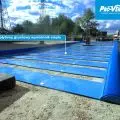Alicja Bakalarska, Julia Ciężar and Matylda Wolska, third-year architecture students at Warsaw University of Technology, received the BB Green Award in the 2021 Modular Home Design Challenge organized by the Bee Breeders platform. The challenge sought innovative modular home designs that demonstrate what a home is and can be in the modern world. Appreciated by the jury, The Family's Background project is a home that adapts to both its occupants and its surroundings.
TheModular Home Design Challenge 2021 is the first in a series of annual competitions organized by Bee Breeders focusing on the concept of modular architecture that is part of the Bee Breeders' Small Scale Architecture Appreciation Movement, which showcases small concepts that incorporate big ideas, as well as the Affordable Housing series run in partnership with ARCHHIVE BOOKS.
Polish students' modular house received BB Green Award
© Alicja Bakalarska, Julia Ciężar, Matylda Wolska
innovative modular home
Modular architecture is one of the most dynamic design elements, offering versatile solutions for efficient, sustainable spaces and building practices. Repeatable or flexible modules can provide configurable and well-designed design solutions without incurring excessive costs. Prefabrication, efficient use of materials, reduced transportation requirements and ease of on-site installation reduce construction time and carbon footprint.
The task of the international competition was to design a modular house that can be built in any form and layout, erecting it in a location of choice: rural, urban or suburban. The jury was looking for design concepts that demonstrate a critical analysis of what a home is and can be in today's increasingly technology-driven world.
The design of a home creates, among other things, walls, shelves, countertops or cabinets
© Alicja Bakalarska, Julia Ciężar, Matylda Wolska
BB Green Award for female PW students
The entries were judged by an international jury of architects and modular design specialists, including Ben van Berkel (UNStudio), Chris Prech (Studio Precht), Mathew Aitchison (Building 4.0 Cooperative Research Center), Camino Alonso, Carlos Alonso and Ignacio Lechón (ÁBATON Arquitectura), Sarah Broadstock (Studio Bark), Enrico De Lotto andGeorge Kolliopoulos (Mandalaki, Monocabin Prefab project), Inés Olavarrieta (selgascano), Ivan Rupnik (Northeastern University College of Arts, MOD X), Ewelina Wozniak-Szpakiewicz (DMDmodular Ltd).
introductory video for The Family's Background project
video: Piotr Wojnar
The works awarded by the jury were selected for their special sensitivity to the environment, innovative use of materials and their feasibility and implementation potential. Among the selected works was a project by third-year architecture students of the Warsaw University of Technology titled The Family's Background, which received a special BB Green Award for its use of green and ecological materials.
The foundation of the house is formed by pillars that allow it to be located on any terrain
© Alicja Bakalarska, Julia Ciężar, Matylda Wolska
background for the family
The idea behind the modular house designed by Alicja Bakalarska, Julia Ciężar and Matylda Wolska is to create a background for the family that inhabits it. As the authors say - the designed object is supposed to identify with the current residents and take on their character. The proposed building also adapts to the location in which it is to be placed.
The filling of its walls depends on the climate and local materials, and the foundation is made up of pillars that allow it to be erected in any conditions. The structure of the building consists of repetitive elements of columns, beams and infill between them, which, depending on the needs of the family, form walls, shelves, countertops or cabinets. Thanks to this idea, even the passageway serves as storage.
Themodule is the structure, not the solid. Producing the pieces requires cutting basic forms out of wood, from which the module and then the house can be assembled. This reduces machine work in the factory, which affects carbon dioxide emissions into the atmosphere, the architects explain.
The module of the house is the structure, not the lump
© Alicja Bakalarska, Julia Ciężar, Matylda Wolska
a house that grows with the number of residents
The plan of the house was expressed by the authors in a nine-field layout, so that the object could grow with the family and change with it. The basic plan assumes a family of three, but depending on the situation, the house can change and expand with additional rooms. When a third bedroom is added, for another family member, the area of the house expands from 77.5 to 90.5 square meters. If necessary - for example, if grandparents move in, the building can be enlarged by a fourth room. Then the total area will increase up to 103.4 square meters.
The house can reach an area of up to 103,4 square meters
© Alicja Bakalarska, Julia Ciężar, Matylda Wolska
See also the design of the INvisible house for the visually impaired, by Patryk Wlodarczyk from the Cracow University of Technology, which received the second prize in the Homefutura competition organized by UNI competitions.
We would like to remind you that the student competition HEALTHYHOUSE is underway. We are looking for designs of single-family and multi-family houses that are user- and nature-friendly, functional and created with residents in mind. Submit your works.























































